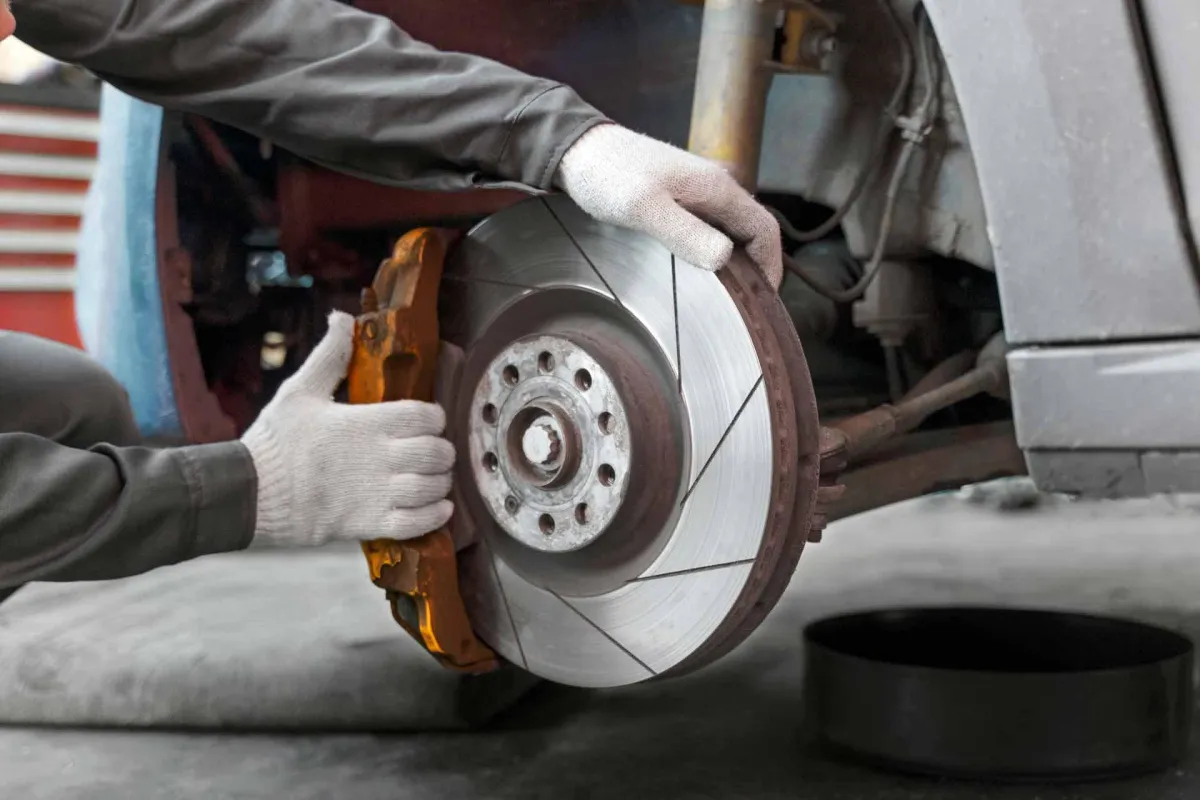East Bethel, MN
Call Us 763-413-7001
FREE Estimates | Factory Warranties on New Auto Parts
Explore our auto repair blog for valuable tips, trends, and maintenance advice


When to Replace Versus Repair Your Brake Rotors
Your car’s braking system is its most important safety feature. When it starts to make noise, vibrate, or feel less responsive, most drivers immediately think of replacing brake pads. But what about the rotors? These steel discs are what the pads clamp onto — and they’re just as crucial for stopping power.
The question is: should you replace your rotors, or can they be repaired? For East Bethel drivers dealing with Minnesota’s mix of snow, slush, and road salt, that answer depends on condition, thickness, and the type of wear your rotors have.
At Transworks Plus, we’ve serviced enough brakes to know there’s a fine line between saving your rotors and wasting money on a temporary fix. Let’s break down how to tell the difference.
How Brake Rotors Work and Why They Wear Out
Each wheel on your vehicle has a rotor — a round, flat disc made of cast iron or carbon composite. When you press the brake pedal, the calipers squeeze the brake pads against the rotors, creating friction that slows your vehicle.
Over time, that friction generates heat and surface wear. In Minnesota’s cold, salty climate, rust accelerates that wear dramatically. Even new rotors can develop grooves, cracks, or uneven surfaces if they overheat or collect road debris.
Common causes of rotor wear include:
Overheating: Caused by repeated hard braking or stuck calipers.
Corrosion: Salt and moisture lead to pitting or flaking.
Uneven pad pressure: Creates high and low spots known as “warping.”
Age and thickness loss: Every time rotors are resurfaced, metal is removed — eventually leaving them too thin to stay safe.
When rotors lose smooth contact surfaces, the brake pads can’t grip properly, leading to vibration, noise, or reduced stopping distance.
Signs Your Brake Rotors Need Attention
Here’s how most East Bethel drivers realize something’s off:
Pulsation when braking: The steering wheel or pedal shakes when stopping.
Squealing or grinding sounds: Pads are hitting uneven or damaged metal surfaces.
Longer stopping distances: Rotor surface wear reduces friction.
Blue or glazed appearance: Indicates overheating and metal hardening.
Visible rust rings or scoring: Deep grooves mean the pads can’t contact evenly.
These symptoms don’t automatically mean you need new rotors — but they do mean it’s time for an inspection.
When Rotors Can Be Repaired
“Repairing” rotors typically means resurfacing, also known as machining or turning. This process removes a thin layer of metal from the rotor’s surface, restoring a smooth and even contact area for the pads.
Resurfacing can be a good option if:
The rotor thickness remains above the manufacturer’s minimum specification.
The damage is surface-level — like light grooves or minor rust buildup.
Both rotors on the same axle can be machined evenly for balance.
The heat spots or warping are minimal and don’t go deep into the metal.
However, resurfacing is not a fix-all. Every pass on a lathe makes the rotor thinner, which affects heat dissipation. Once it’s too thin, it can warp easily or even crack under pressure.
For most modern vehicles, the cost difference between resurfacing and replacement is small — which is why many mechanics recommend replacement when wear is advanced.
When Rotors Must Be Replaced
Replacement is the only safe choice when:
Rotors are below minimum thickness. The “discard thickness” is usually stamped on the rotor edge. Going thinner means less heat capacity and higher risk of failure.
Severe corrosion is present. Rust can’t be safely machined away without compromising strength.
Cracks, deep grooves, or hard spots appear. These are signs of metal fatigue and overheating.
Uneven wear is excessive. If the rotor face is too distorted, resurfacing won’t make it flat enough for consistent braking.
Replacing rotors also makes sense when you’re installing new brake pads after years of use. Old rotor surfaces can cause new pads to wear unevenly, reducing lifespan and braking efficiency.
How Transworks Plus Inspects and Decides
During a brake inspection, our technicians measure rotor thickness with a micrometer and check for warping with a runout gauge. We look for:
Exact measurements vs. manufacturer limits
Heat discoloration and glazing
Surface smoothness and pad contact patterns
Rust and edge flaking
Based on that, we’ll let you know if resurfacing is safe or if replacement is the smarter long-term choice. We use OEM-quality rotors designed for Minnesota’s temperature swings, ensuring quiet, consistent performance even in icy conditions.
FAQs About Brake Rotor Service
Can I replace brake pads without replacing rotors?
Yes, if the rotors are still within spec and not damaged. But skipping worn rotors can cause new pads to wear unevenly and lose performance.
What happens if I ignore bad rotors?
Vibrations and uneven wear can spread to other parts like calipers and wheel bearings. Worst case, braking distance increases — a serious safety risk.
How long do brake rotors last in Minnesota?
Typically 30,000–70,000 miles, depending on driving style and winter conditions. Salt and moisture can shorten that lifespan significantly.
Are drilled or slotted rotors better?
They can improve cooling and reduce brake fade, but for daily driving in East Bethel, high-quality standard rotors are more cost-effective and durable.
Should rotors be replaced in pairs?
Always. Uneven braking force can cause the car to pull to one side and wear new parts prematurely.
The Bottom Line
Your rotors work hard every time you stop your car — and they’re exposed to some of the harshest conditions Minnesota can throw at them. Knowing when to repair or replace them isn’t guesswork; it’s about safety, smoothness, and smart maintenance.
At Transworks Plus in East Bethel, our brake inspections go beyond a quick visual check. We measure, test, and advise based on what keeps you safest on the road. Whether your rotors can be resurfaced or should be replaced, our goal is the same: precise stopping power and confidence behind the wheel.

Schedule Your Auto Services Today
Keep your vehicle in top condition with our professional maintenance services. Book your next appointment now to ensure your car runs smoothly and efficiently.
Get started on reliable vehicle performance today.
FOR DIAGNOSTICS, MAINTENANCE, OR ANY AUTO REPAIR NEEDS

CALL US
(763) 4137 001

AUTO SERVICES

CONTACT INFORMATION
Call us: 763-413-7001
Address:
18607 MN-65, East Bethel, MN 55011
Business Hours
Mon - Fri: 7:30 AM– 5:00 PM
Sat & Sun: Closed
© 2025 All Rights Reserved | Transworks Plus | Privacy Policy
